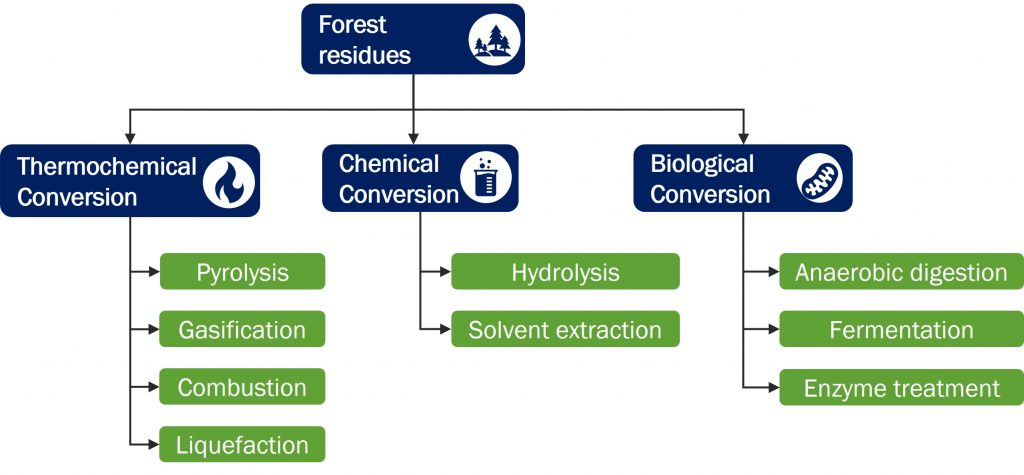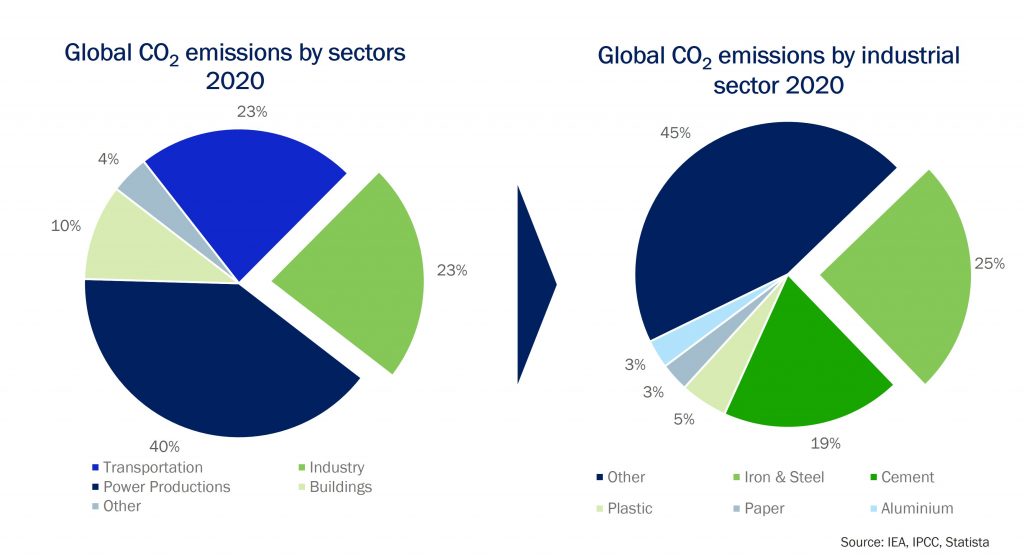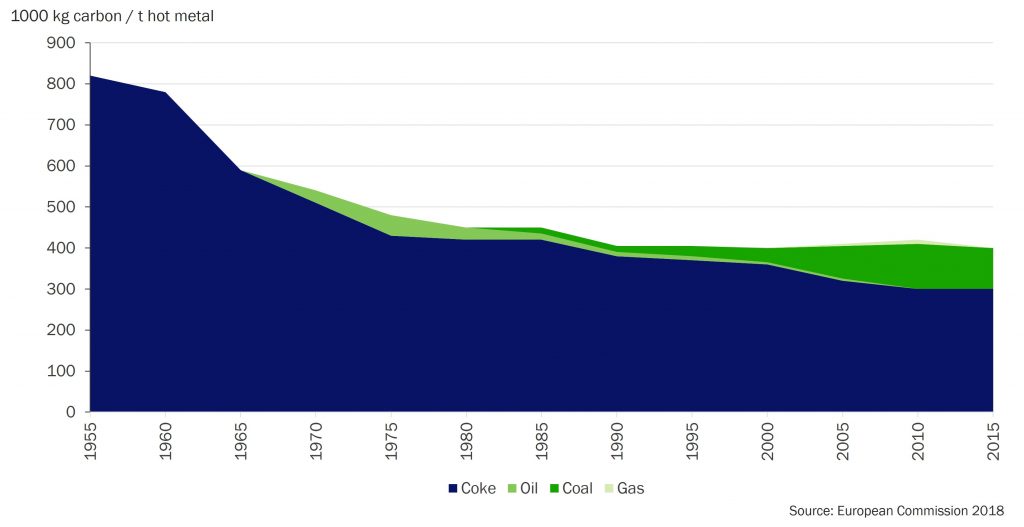The green transition is a game changer
The green transition, or the shift from growth that relies on fossil fuels to growth based on green solutions, has accelerated in recent years. Green development programmes, such as the European Union Green Deal program and EU fit for 55 packages, have set the pace, as have corporations and investors that are factoring ESG considerations into their investment decision-making processes. The move away from fossil fuels promotes the discovery and utilisation of more renewable feedstock alternatives and pathways to generate more sustainable products.
Forest residues in the spotlight
Forest residues are one of the most promising renewable feedstocks due to their availability, cost, and independence from the food industry. Forest residues can be converted into a variety of products, including biofuels, biochemicals, and biomaterials, which can replace the use of fossil fuels in the production of steel, chemicals, and transportation fuels. Different conversion pathway routes open new potential for the utilisation of forest residues, as well as assisting industries that are challenging to decarbonise in steering their production shift towards a circular economy.
 Figure 1: Different conversion methods of forest residues
Figure 1: Different conversion methods of forest residues
Understanding the value chain of a new raw material is essential
The ongoing rapid transition in the energy sector, new potential biofuels, biochemical and biomaterial operators, and current forest residue users will all have an influence on regional forest residue supply-demand balances. This will generate additional challenging problems for many operators, such as whether there is enough forest residue for everyone, as well as how to manage feedstock procurement and logistics in a sustainable manner. Particularly if the procurement of forest residues has not previously been a core competence of the organisation. However, because of the increased paying capability, the price development of forest residues will drive consumption of forest residues towards higher value-added products. Aside from the pricing, the operator can gain a competitive edge by using forest residues consistently throughout the year and building a long-term partnership with energy producers, for example. Therefore, understanding the new value chain of a new raw material is essential in order to achieve a feasible production process in a tightening business climate and sustain close collaboration with forest residue suppliers.
Decarbonising iron and steel industry
For instance, iron and steel sector could be a new potential user of forest residues. Steel is a key material in modern industrial society by being the most important building material in infrastructure, machinery, and technology. The increasing use of steel is necessary to meet the rising social and economic welfare needs. However, iron and steel industries are one of the most energy intensive industries accounting for 4-7% of the total global emissions and a similar range in Europe.
Figure 2. Global emission by sectors and industries 2020.
Demand growth of iron and increasing emissions presents challenges for the steel sector which seeks to find more sustainable pathway to produce iron and steel.
The iron ore reduction process accounts for the majority of CO2 emissions in the steel manufacturing process. Iron ore reduction process requires a considerable amount of energy and an oxidising agent to reduce iron ore to its metallic form. Coke is a suitable raw material for this purpose because it provides energy to the process, functions as a reducing agent, and serves as a support medium for the burden material.
Much has been accomplished, but much remains to be done
Steel industries have increased their efficiency of steel production in recent years by, for example, better optimising their processes and using more waste heat. However, improving resource efficiency in steel production can only reduce emissions to a limited extent. As a result, there are no low-hanging fruits in the tool kit that would drastically cut emissions generated during the steel production process.
Figure 3 illustrates the evolution of the blast furnace over time by presenting the needed carbon-to-hot-metal ratio. The image shows that there have not been significant technological advances in recent years, and the thermodynamic limitations of traditional manufacturing systems have nearly been reached.
According to the steel institute VDEH’s study, the maximum CO2 emissions reduction potential in the European steel industry is around 57% in 2050 compared to 2010 levels. However, this would require the use of expensive and uncertain carbon capture systems (CCS) and retrofitting of blast furnaces. One alternative pathway to radically reduce CO2 emissions is to substitute the use of fossil coke with bio-coke derived from forest residues via a high pyrolysis process. If the qualities of renewable carbon are similar to those of fossil coke, using bio-coke in the manufacturing process does not require major technological adjustments to the present technology, as is the case is with green hydrogen. Also, the availability of green hydrogen is limited and coke is still needed in steel productions that utilises ferrochrome as raw material. Bio-coke utilisation could be gradually increased, initially to manage operational use and later according to desired fossil CO2 emission allowance limits.
Could bio-coke be one of the solutions to the sustainability challenge?
Bio-coke can be produced through high temperature pyrolysis process of renewable biomass, such as forest industry residues. The pyrolysis process is a thermal decomposition of material in the absence of oxygen. In the high temperature of the pyrolysis process, the wood cell structure breaks down into smaller molecules while volatile matter is released. The volatile matter distills off forming syngas, while the content of fixed carbon and ash remain in the biochar, with the reaction yield of around 20%.
Figure 4. The effect of temperature on the pyrolysis process.
As a result of the reaction yield, the bio-coke production plant requires a significant quantity of wet forest residues, forcing a focus on the effective use of raw materials and syngas, forest residue sourcing, availability, and logistics. Creating industrial symbiosis, in which many enterprises complement one another, is one technique to achieve effective usage of raw materials and side streams. Throughout the year, the formed syngas could be directed to the production of different value-added bioproducts such as ammonia, methanol, or Fischer Tropsch-liquids.
Collaboration is king
Business ecosystems based on industrial symbioses create a competitive advantage over traditional industrial value chains. The collaborative development of industrial symbioses introduces a new efficient method for developing and manufacturing new products and innovations, while reducing emissions and waste. These system integrations are essential for more difficult-to-decarbonise sectors, and they assist companies in steering their production shift toward a circular economy while also opening new opportunities. At the same time, these present opportunities for the European Union to reach ambitious climate targets while also pushing companies to develop new clean and complex technologies that are projected to play a growing role in the global economy.
As existing and new competitors compete for the same raw materials, new technological solutions increase competition for forest residues. However, a tighter market always provides new opportunities and opens new innovative solutions, all of which lead to more effective utilisation of raw materials, side streams, and energy. To maintain a competitive edge going forward, various sector players will need to collaborate even closer together at the forefront of the pack.
On the author: Jussi Räsänen, Consultant. Jussi holds a MsC in Chemical Engineering and has a background as senior process engineer. He has a strong interest in bio-based materials and new energy solutions.
Vision Hunters provides strategic advisory services for the forest and bio-based industries, and energy sectors. We assist leadership teams in making the smartest strategic choices to improve the outcome of their company in the future. We are highly experienced and result-oriented and have advised many of the leading companies in our industry.


